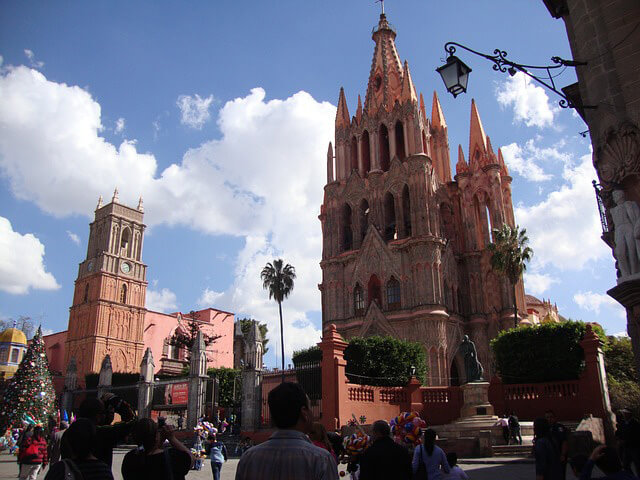Retirement in Mexico
Why, Where, and How North Americans Relocate
By Habeeb Salloum

|
|
Retirement in Mexico: Cathedral in popular San Miguel de Allende.
|
During the cold winter months over 1 million North Americans bask in the tropical warmth of Mexico, with the number rapidly growing (some unofficial estimates put the number of foreigners much, much higher). More Americans move to Mexico than any other country. Some return each spring, while others are year-round residents.
Where to Retire in Mexico?
Some resident travelers head for the hot coastal zones; others prefer the temperate zones, 3,000 to 6,000 feet above sea level.
For those seeking spring-like weather all year long, Guernavaca and Guadalajara and the nearby lakeside towns of Chapala and Ajijic are the preferred locations. Guadalajara, along with Chapala and Ajijic, is home
to 50,000 North American expatriates, the largest colony of retired Canadians and Americans in Mexico. Many more snowbirds travel to the area to spend the winter months. Both towns maintain a small-town and relaxed atmosphere. Ajijic,
one of the most picturesque towns in Mexico, offers cobblestone streets, gourmet dining, and excellent shopping.
The nearness to the large and livable city has advantages for retirees, some of whom prefer to live in the city itself, a metropolis filled with Mexican cowboys, tree-lined boulevards, fountains, parks, and plazas.
Other cities becoming more popular for North Americans are San Miguel de Allende, Morelia, and Oaxaca. San Miguel de Allende, declared a national monument in the 1920s, is a legendary town of artisans and poets. It
is filled with colonial mansions, terraced cobblestone streets, and flower-filled patios. Its North American expatriate colony of 20,000-30,000 organizes plays and lectures and even publishes a newspaper in English. It is said to be the perfect
town for English-speaking retirees in Mexico who are looking for ties with North American social groups.

|
|
Near a Yucatan beach: One of many locations North Americans choose to retire.
|
Morelia is the capital and the cultural and political center of Michoacan, a state renowned for its natural beauty. Its friendly inhabitants, along with its Spanish colonial and indigenous heritage, make it ideal
for someone interested in Mexican culture. It is home to dozens of artists, poets, and writers and a small community of Canadians and Americans. Retirees come to Morelia because of its low real estate prices as well as the ample opportunities
of interaction with the local inhabitants.
Oaxaca, located on a 5,000-foot-high plateau, though not as yet the most popular destination for North Americans, entices by its climate, cuisine, handicrafts, and history. Its downtown streets are lined with impressive
Baroque colonial architecture. The city's pace is relaxed and the people are friendly. Oaxaca is becoming another important Mexican destination for North American retirees.
More Info on Retirement in Mexico
1. Depending on the retiree's plans for staying in Mexico, there are different visa procedures. For someone looking to stay in Mexico for a short period a tourist visa (FMT) is relatively easy to obtain. It is valid
for up to six months but does not grant work status.
2. Rentista or Residente Temporal is a non-working visa available to those wishing to stay longer than 6 months and less than 4 years who can prove sufficient income. See the rentista visa section of the Mexican consular services website for all requirements. Mexperience has a good detailed explanation of the various visa options, including the Residente Permanente option for those who plan to move long-term or permanently.
3. Owning or renting a home in Mexico is relatively easy. Foreigners can buy directly in any area that is not near the coast or the border. If the property is within 60 miles of the border or 30 miles of the
coast, non-Mexicans are required to purchase through a fideicomiso (beneficial trust).
4. Medical benefits stop at the border, so it is advised that Canadian and American retirees in Mexico buy health insurance. In general, the quality of healthcare in Mexico is very good. Hospitals, both private
and public, are usually easily accessible and well equipped.
5. Generally speaking, there is no need to have a car in Mexico; public transportation is affordable and reliable.
For more information, contact the Mexican Tourism Board.
See our section on Living in Mexico: Expatriate Resources for more articles and resources for living and moving to Mexico.
|
HABEEB SALLOUM lives in Toronto, Ontario.
|
